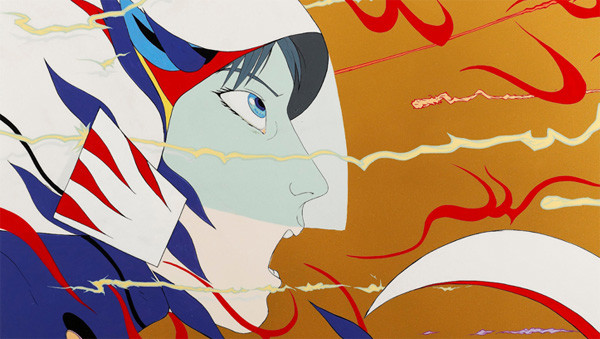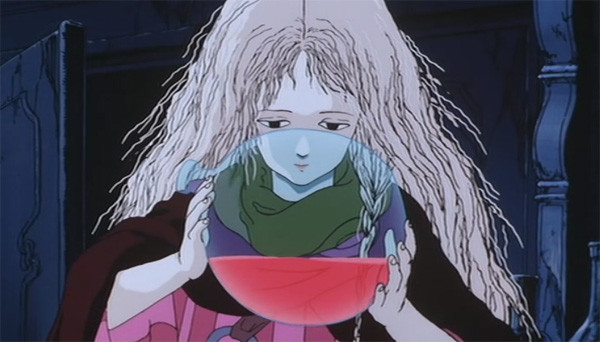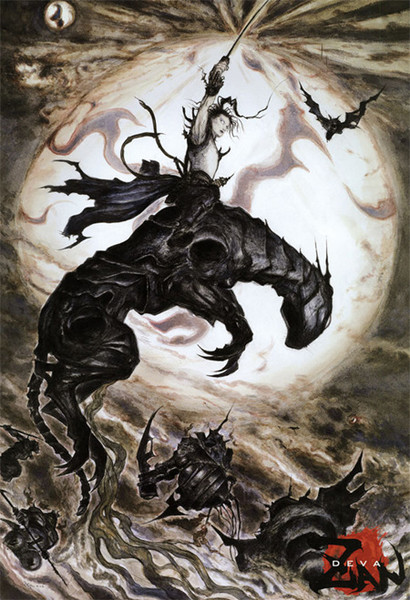Interview: Yoshitaka Amano
by Todd Ciolek,Yoshitaka Amano has few equals. Many artists have jumped from anime to video games to novel illustrations, but Amano's always connected to something big. He began his career at Tatsunoko Productions, working on some of the biggest anime hits of the 1970s. In the following decade, he became the artist for Hideyuki Kikuchi's Vampire Hunter D novels as well as a little game called Final Fantasy. Both proved to be long-time gigs, and Amano's provided character designs and artwork to Final Fantasy games ever since.
There's far more to Amano than his work on animation and games, of course. His flowing, unmistakably ornate style to Lady Murasaki's The Tale of Genji, Neil Gaiman's Sandman, Kaoru Kurimoto's The Guin Saga, and many other comics and novels. He's also devised many original projects, including Hero, N.Y. Salad, and over a dozen art books. His latest creation is Deva Zan, the tale of a mysterious samurai tracking lost gods across time and space. Dark Horse plans to release the Deva Zan novel, which Amano wrote and illustrated, this October, while a Deva Zan movie is in the works.
Amano recently attended the New York Comic Con, where he found time to answer a few questions about his impressive career.
At your Comic-Con panel, you mentioned that your favorite artists as a kid were Disney animators for films like Bambi and Snow White. When you were older and studying art, who were your favorite artists?
Neal Adams was one of them. I wasn't really into fine art at the time, but there weren't many options for American superhero comics in Japan. In the '70s, I was into Peter Max and Andy Warhol, as pop art started to come to Japan.
How did you come to join Tatsunoko Productions when you were only 15 years old?
It was an act of fate, I think. I lived in Shizuoka when I was a third-year student in high school. I went to Tokyo to visit my friend, and my friend happened to live next door to Tatsunoko Productions. So we went and walked around and took a tour. I drew a picture for them and submitted it, and the next day they called up and said they'd like to have me there. So without telling my parents, I signed on right there.
So you went to school at the same time you were working at Tatsunoko?
I moved to Tokyo and went to high school while I was working at Tatsunoko, but after a while I just went to work at Tatsunoko full-time.

You designed characters for a multitude of shows, from ‘70s staples like Gatchaman to ’80s series like Mospeada. What major changes did you see in anime character design between those two decades? What trends did you see come and go?
It wasn't so much the trends, but I was influenced by different sources throughout the decades. In the 70s, Bruce Lee was in the spotlight, so I was influenced by that. Another example is Time Bokan. I was into pop art at the time, so that influenced my taste there. But I don't think trends like those are a bad thing for shows.
Bruce Lee inspired Hurricane Polymar, right?
Yes. I'm surprised you've heard of Polymar.
At the time Tatsunoko was such a magical place. Everyone was in their twenties, the best time of their lives, and they were all doing the things they wanted to do. A lot of people might say they were making shows for children, but they were just having a good time. It was the most amazing place to be, both for that period in history and in my life.

You collaborated on the film Angel's Egg with Mamoru Oshii. People still debate the themes of the film today, and some wonder how much of the story was yours and how much was Oshii's. Is there anything you'd like to say about the meaning of the film?
It was really Oshii's project. I'm not sure if I should talk about this, but at the time Oshii was getting divorced and he had a daughter he couldn't see. So he felt that he was creating some unhappy memories and unhappy times for his daughter, and perhaps that experience resulted in Angel's Egg. But that's something I heard well after the fact.
The worldviews of Oshii and I are a little different. I think Oshii brought a more religious angle to the film. That wasn't my doing so much as it was Oshii's. I was more into the fantasy part. That was our collaboration. So when you look at those portions of the film, the religious and esoteric part is Oshii and the fantasy element is me. For Angel's Egg, I went to look at fossils, and that was a movement of inspiration for me.
Angel's Egg is a your-results-may-vary movie, where if you don't know a lot about movies you won't get a lot out of it. There's a film called The Spirit of the Beehive that influenced it, with its stories of Frankenstein's monster and a soldier and two children. You're more likely to appreciate everything as a gestalt if you have an appreciation for movies than if you just watch it dry.
You've designed many characters for the Final Fantasy series. Was there any character that you had to redesign more than any other? Which one was the most memorable?
The one I remember the most is a female character who carried a whip around and was to be a strong woman. But they decided to drop her at the last minute and she never made it into the game. I don't know if she changed the most, but that's one I wanted to work on and develop a little more. If you check the artbook The Sky, there's a lot of stuff that was never used. She's probably in there.
Which game was she going to appear in?
It was so long ago that I don't remember. The more I deviate in my characters, the more interesting they get, and the ones that end up on the cutting room floor are often the ones I like the most.

Deva Zan is the first book you've written as well as illustrated. How have you found the experience?
Usually when an illustrated novel comes about, the words come first. But I'm not the best at elucidating my points when it comes to words. I'm better at illustrations. With this, I wanted to do the illustrations first and then tie everything together with words. But I didn't want to focus too much on writing, or else it becomes too much a novel. So I wanted to make sure that there was a good mix of the two and that the final product was greater than the sum of the two parts.
Will the Deva Zan movie cover the same ground as the book, or will they be separate stories?
When when the animation gets made—it's still in the development and funding stages—I hope it'll become something different. With the Deva Zan book, I've just formed a core of dense principles of what I want the world to be. If it becomes a movie or a game, I hope they'll develop their own unique aspects for those particular media.
And that's what I want. I've never drawn Vampire Hunter D the same. Every time I draw him, he's different. I think that in permutation there's beauty, and there are more interesting things that'll develop from it. And it'll be different from the book itself.
So it'll be a game as well?
In terms of what's in development, right now they're talking about a movie or perhaps a TV series in Japan. The book is being put together for the first time in English, and it'll be sublicensed back into the Japanese market. So Japanese readers will get it after the English-speaking world.
Lastly, a question about Takoman, the octopus superhero you've created. I understand that you're still waiting for Dark Horse president Mike Richardson to write the story for you, but what can you tell us about the general idea for the character? Would he be a Japanese or American superhero?
It would take place in New York City, and he'd be American.
discuss this in the forum (9 posts) |